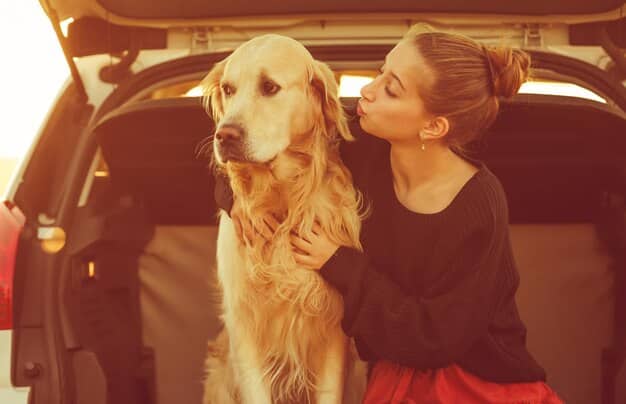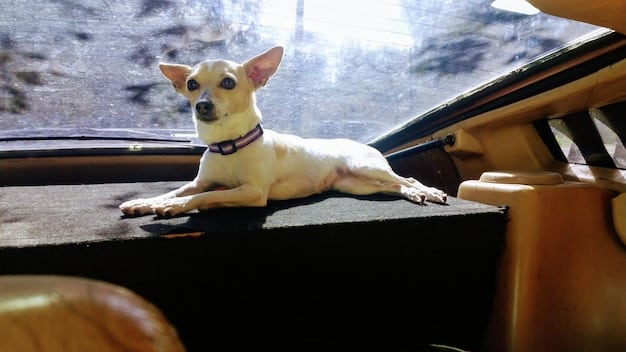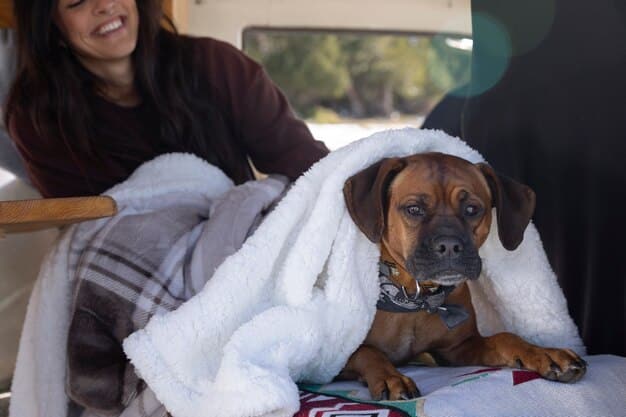Car Ride Anxiety: 5 Steps to Stress-Free Dog Trips

Car ride anxiety in dogs can turn essential trips into stressful ordeals; however, implementing gradual desensitization, creating a comfortable and safe car environment, using calming aids, practicing positive reinforcement, and consulting with a vet or behaviorist can help make car trips stress-free for your furry friend.
Does your dog dread car rides? Car ride anxiety is a common problem, but with the right approach, you can transform those stressful trips into peaceful journeys for both you and your canine companion.
Understanding Car Ride Anxiety in Dogs
Many dogs experience anxiety related to car rides. It’s important to understand the reasons behind this anxiety to address it effectively. Identifying the root cause can guide your training and management strategies.
Common Causes of Car Anxiety
Several factors can contribute to a dog’s fear of car travel. These can range from past negative experiences to more inherent predispositions.
- Motion sickness: Dogs, especially puppies, can experience motion sickness, leading to nausea and anxiety.
- Past trauma: A previous car accident or a stressful trip to the vet can create negative associations.
- Confinement: Some dogs feel trapped or restricted in a car, triggering anxiety.
- Association with negative events: If car rides always lead to unpleasant experiences like vet visits, dogs may develop a fear response.
Recognizing the Signs of Anxiety
It’s crucial to recognize the signs of anxiety in your dog so you can intervene early and prevent the fear from escalating. Observable behaviors can signal your dog’s discomfort.
- Panting and drooling: These are common signs of stress in dogs.
- Pacing and restlessness: An anxious dog may be unable to settle down.
- Whining or barking: Vocalizations can indicate fear or distress.
- Trembling: Shaking can be a clear sign of anxiety.
By understanding the causes and recognizing the signs, you’re better prepared to implement effective solutions and create a more positive car travel experience for your dog. Stay patient and consistent as you work through these strategies.

Step 1: Gradual Desensitization to the Car
Desensitization is a proven method for reducing anxiety by slowly exposing your dog to the source of their fear in a controlled manner. The goal is to create positive associations with the car over time.
Start Small and Build Up
Begin with simple steps, gradually increasing exposure as your dog becomes more comfortable. Don’t rush the process; each dog progresses at their own pace.
- Introduce the car: Start by simply approaching the car with your dog. Offer treats and praise for calm behavior.
- Enter the car (no trip): Once your dog is comfortable near the car, encourage them to enter it while it’s parked. Again, use treats and praise.
- Short trips around the block: When your dog is relaxed inside the car, take very short drives around the block. Keep the atmosphere positive with a calm voice and gentle petting.
Make It a Positive Experience
Ensure that each interaction with the car is a positive one. If your dog shows signs of anxiety, slow down or return to a previous step.
- Use high-value treats: Reserve special treats that your dog only gets during car-related activities.
- Play calming music: Soothing music can help reduce anxiety levels.
- Bring a favorite toy: A familiar toy can provide comfort and distraction.
Gradual desensitization is key to changing your dog’s perception of car rides. Be patient, stay consistent, and celebrate small victories along the way. With time and positive reinforcement, your dog can learn to associate the car with pleasant experiences.
Step 2: Creating a Comfortable Car Environment
A comfortable and safe environment can significantly reduce anxiety during car rides. Make sure your dog feels secure and relaxed in the vehicle.
Secure and Comfortable Seating
Proper seating arrangements play a crucial role in your dog’s comfort and safety. Avoid letting your dog roam freely in the car.
- Use a dog car seat or carrier: These provide a secure and comfortable space for your dog.
- Non-slip mat: A non-slip mat will help your dog maintain balance.
- Buckle up: A dog seat belt harness can keep your dog safe and secure during the ride.
Optimal Temperature and Ventilation
Maintaining a comfortable temperature and ensuring good ventilation are essential for your dog’s well-being.
- Adjust the air conditioning: Make sure the car is neither too hot nor too cold.
- Open a window slightly: Fresh air can help alleviate motion sickness and anxiety.
- Provide shade: Use sunshades to protect your dog from direct sunlight.
By prioritizing your dog’s comfort and safety, you can turn the car into a relaxing space rather than a source of fear. Remember to monitor your dog’s behavior and adjust the environment as needed to keep them calm and content throughout the journey.

Step 3: Utilizing Calming Aids and Supplements
Calming aids and supplements can be valuable tools in managing car ride anxiety. These products work to reduce stress and promote relaxation.
Over-the-Counter Calming Aids
Several over-the-counter products are designed to ease anxiety in dogs. It’s always best to consult with your veterinarian before introducing a new supplement or aid.
- Pheromone diffusers and sprays: These products mimic natural dog pheromones that promote relaxation.
- Calming treats: Many treats contain ingredients like L-theanine or chamomile, which have calming effects.
- Anxiety vests: These vests apply gentle pressure, similar to swaddling a baby, to help dogs feel more secure.
Prescription Medications
In some cases, your veterinarian may recommend prescription medications to manage severe anxiety. These medications should be used under veterinary supervision.
- Anti-anxiety medications: Drugs like trazodone or alprazolam can help reduce anxiety levels.
- Motion sickness medications: If motion sickness contributes to anxiety, drugs like Cerenia can help.
When using calming aids and supplements, follow the instructions carefully and monitor your dog for any adverse reactions. These aids can provide significant relief when combined with other strategies, making car rides more manageable for anxious dogs. Always ensure you’re using products that are safe and appropriate for your pet’s specific needs.
Step 4: Employing Positive Reinforcement Techniques
Positive reinforcement is a powerful way to build positive associations with car rides. By rewarding calm behavior, you can gradually change your dog’s perception of the car.
Reward Calm Behavior
Focus on rewarding your dog for remaining calm and relaxed during car-related activities. Positive reinforcement can significantly reduce anxiety over time.
- Treats and praise: Offer treats and verbal praise when your dog is calm near or inside the car.
- Interactive toys: Engage your dog with a puzzle toy during the ride to keep them distracted and content.
- Affection: Gentle petting and reassurance can help your dog feel safe and secure.
Avoid Punishment
Punishment can exacerbate anxiety and create negative associations with car rides. It is essential to use only positive reinforcement techniques.
- Never yell or scold: This can increase your dog’s fear and anxiety.
- Avoid forcing your dog: Forcing a dog into the car will likely make the problem worse.
- Focus on rewards: Consistently use positive reinforcement to create a positive experience.
Positive reinforcement not only helps to reduce anxiety but also strengthens the bond between you and your dog. Make each car-related interaction a positive one, and your dog will gradually learn to associate the car with pleasant experiences rather than fear. Consistency is key to achieving long-term success in managing car ride anxiety.
Step 5: Consulting with a Veterinarian or Behaviorist
For persistent or severe car ride anxiety, seeking professional help from a veterinarian or behaviorist is advisable. They can provide tailored solutions and address underlying issues.
Veterinary Evaluation
A veterinarian can rule out any underlying medical conditions that may be contributing to your dog’s anxiety. They can also recommend appropriate medications or supplements if necessary.
- Physical exam: To check for any health issues causing discomfort.
- Medication assessment: To determine if anti-anxiety or motion sickness medications are appropriate.
- Nutritional advice: To ensure your dog’s diet supports overall health and well-being.
Professional Behaviorist Assistance
A certified dog behaviorist can develop a customized training plan to address your dog’s specific anxiety triggers. They can provide guidance on desensitization techniques and behavior modification strategies.
- Behavioral assessment: To identify the root causes of the anxiety.
- Training plan: A tailored plan to address specific fears and behaviors.
- Ongoing support: Regular sessions to monitor progress and adjust the plan as needed.
Seeking professional help can provide valuable insights and effective strategies for managing severe car ride anxiety. A veterinarian or behaviorist can offer personalized solutions that address your dog’s unique needs, ensuring the best possible outcome for both you and your furry friend. Early intervention can significantly improve your dog’s comfort and well-being during car rides.
| Key Point | Brief Description |
|---|---|
| 🚗 Gradual Desensitization | Slowly introduce your dog to the car, starting with just being near it and gradually increasing exposure. |
| 💺 Comfortable Environment | Ensure the car is comfortable with secure seating and optimal temperature. |
| 💊 Calming Aids | Use calming aids like pheromone diffusers or consult your vet for medication options. |
| 🐾 Positive Reinforcement | Reward calm behavior with treats and praise to create positive associations. |
Frequently Asked Questions
▼
Dogs might fear car rides due to motion sickness, past negative experiences like vet visits, or feeling confined. These factors can create anxiety.
▼
Signs of car anxiety include panting, drooling, pacing, whining, barking, trembling, and an overall inability to settle down. Watch for these indicators.
▼
Over-the-counter options include pheromone diffusers, calming treats with L-theanine or chamomile, and anxiety vests that apply gentle pressure. Always consult with your vet.
▼
Yes, positive reinforcement can create positive associations with car rides. Reward calm behavior with treats and praise, which helps change your dog’s perception.
▼
If your dog’s anxiety is severe or persistent, consult a vet. They can rule out medical issues and may recommend medications or behavioral therapy for more effective results.
Conclusion
Addressing car ride anxiety in dogs requires patience, consistency, and a combination of strategies. By implementing gradual desensitization, creating a comfortable car environment, using calming aids, employing positive reinforcement, and seeking professional help when needed, you can transform stressful trips into peaceful journeys for both you and your furry friend.





